Exploring the Mega Shark Tooth: A Multifaceted Examination
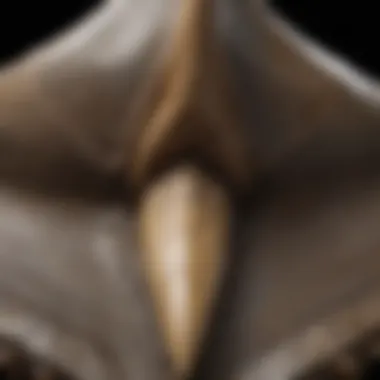

Intro
The fascination with mega shark teeth extends far beyond mere curiosity; these ancient relics tell stories of a time when gigantic predators roamed the oceans. With their formidable size and distinct characteristics, mega shark teeth serve as tangible links to prehistoric life. Collectors, paleontologists, and enthusiasts all share an interest in understanding their multifaceted history and significance. This guide aims to unravel the various dimensions of these remarkable specimens, shedding light on their historical importance, collection methods, and the cultural lore that has emerged around them.
Featured Collectible of the Month
Overview
Each month, we spotlight a distinctive mega shark tooth to pique the interest of collectors. This month, we focus on the tooth of the famous Megalodon—one of the largest and most ferocious sharks that ever swam the seas. Found primarily in areas once submerged by oceans, this tooth can measure up to seven inches in length, often characterized by its distinctive triangular shape and serrated edges.
This featured collectible not only captures the imagination but also invites discussions on geological formations where these fossils are found, providing context on how such ancient beings once lived.
Historical Significance
The historical significance of mega shark teeth lies not just in their size but also in their implications for understanding marine ecosystems. Fossils of sharks date back over 400 million years, and the Megalodon, in particular, existed roughly 23 to 3.6 million years ago. These teeth offer insights into the predator-prey dynamics of ancient oceans, helping researchers piece together the evolutionary history of sharks.
"Mega shark teeth are not merely collectibles; they are time capsules that grant us glimpses into prehistoric ecology and evolution."
Collectors often find themselves enamored by the idea that they hold a piece of the past, connecting them to a time when creatures like the Megalodon ruled the waters. The thrill of uncovering one of these teeth can be likened to discovering a lost chapter in Earth's history.
Identification Techniques
Visual Characteristics
Identifying mega shark teeth can be an art in itself. While size plays a critical role, collectors should also pay attention to several key visual characteristics:
- Shape: Mega shark teeth typically exhibit a robust triangular shape with serrated edges. Their general outline may vary according to the species, but the overall form is generally recognizable.
- Color: Most teeth present a range of hues from black to dark brown, though some may appear gray or even sandy yellow.
- Texture: The surface may exhibit wear from the elements, and preservation conditions can lead to distinct patinas, contributing to their uniqueness.
Understanding these characteristics is vital not just for identification but also for determining the value of a specimen in a collector’s repertoire.
Resources for Identification
To aid in the identification process, several resources stand out as must-have tools for any serious collector:
- Books: Works like "Shark Teeth: A Collector's Guide" provide foundational knowledge and imagery for proper identification.
- Online Forums: Platforms such as reddit.com boast communities dedicated to fossil discussions, where collectors can share their finds and seek expert opinions.
- Museums and Exhibitions: Visiting natural history museums can further enrich one’s understanding and provide opportunities to view rare specimens up close.
As we continue to explore the world of mega shark teeth, it becomes clear that these fossils encapsulate not just scientific interest, but also deep-rooted cultural connections that span centuries.
Preamble to Mega Shark Teeth
Diving into the topic of mega shark teeth reveals a fascinating world where paleontology, geology, and even cultural significance intersect. These massive, fossilized wonders are not just remnants of ancient marine predators; they serve as critical clues in understanding Earth's prehistoric ecosystems and the evolution of marine life. The importance of examining these teeth lies in their ability to tell stories—stories of a time long gone, where colossal sharks roamed the seas, dominating their domains with raw power.
As we embark on this exploration, it’s worth noting that understanding mega shark teeth doesn’t merely enhance the knowledge for collectors or enthusiasts. It also opens up broader discussions about environmental changes over millions of years, contributing to a more nuanced appreciation of biodiversity and extinction. Knowing how these teeth formed, fossilized, and what they represent can shed light on current marine issues.
Definition and Characteristics
Mega shark teeth, often attributed to magnificent creatures like the Megalodon, possess distinct features that differentiate them from other shark teeth. Characteristically, they are large—sometimes exceeding seven inches—and exhibit a unique triangular shape with serrated edges. The coloration can vary, with shades ranging from deep black to cream or brown, depending on the mineral content in the sediment where they were found. Their size and form illustrate immense predatory capabilities, suggesting that these ancient sharks were formidable hunters.
Some defining characteristics
- Size: Mega shark teeth are among the largest known, essential in identifying their origin.
- Shape: The distinct triangular outline with serrations showcases their functionality.
- Fossilization: The preservation process can often display intriguing patterns and textures.
Understanding these attributes not only aids in identification for collectors but also enhances appreciation for the biological adaptations of these prehistoric animals.
Significance in Paleontology
The significance of mega shark teeth in paleontology extends beyond their physical attributes. They serve as vital evidence in understanding the evolutionary history of sharks. These teeth have been crucial in reconstructing ancient marine environments and the ecological dynamics of past eras.
For paleontologists, the study of shark teeth can provide insights into:
- Diet and feeding behaviors: Analysis of tooth wear patterns indicates what these sharks consumed.
- Habitat recognition: Fossil locations help determine the environments in which these predators thrived.
- Evolutionary lineage: Teeth from different periods reveal changes in species and adaptations to environmental shifts.
In short, mega shark teeth are indispensable tools in piecing together the grand narrative of life on Earth. They help contextualize the evolutionary journey of marine life against the backdrop of significant geological events, showcasing that these ‘simple’ artifacts are anything but average.
"When we dig into the past, shark teeth often act as a key to unlock the doors of prehistoric mysteries."
Understanding the role of mega shark teeth in paleontology enriches both our knowledge base and our appreciation for the ancient mariners that once ruled the depths.
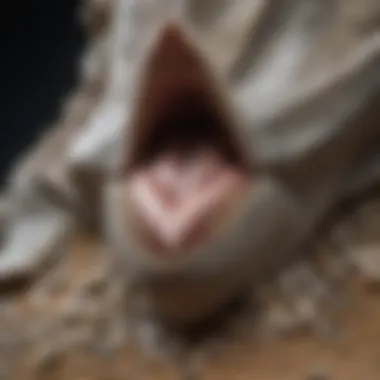
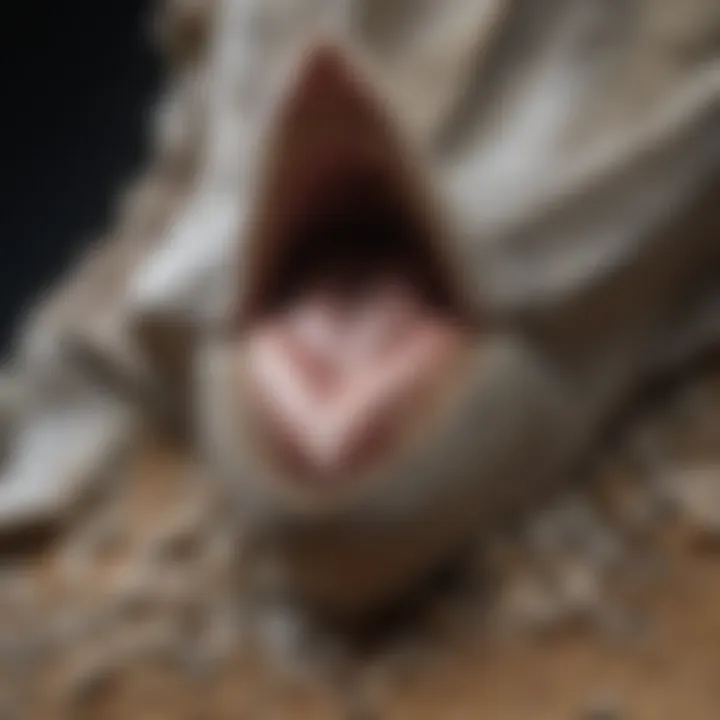
The Evolutionary Journey
The evolutionary journey of sharks provides a fascinating glimpse into the ancient history of these formidable creatures, particularly when focusing on their dental remains. Understanding the evolutionary path that led to the development of mega shark teeth, like those of the Megalodon, is imperative for uncovering the broader implications within marine biology and paleontology. These teeth not only serve as evidence of the sharks’ adaptability and ecological roles over millions of years, but they also assist in reconstructing past marine environments and highlight changes that have taken place through geological epochs. By studying these ancient teeth, scientists can gain valuable insights into the life cycles of shark species, their hunting strategies, and their responses to environmental changes.
Ancient Shark Species
The history of sharks stretches back over 400 million years, marking a long and intricate evolutionary journey. Among the notable ancient sharks, Cladoselache stands out; it's regarded as one of the earliest known shark species, existing during the Devonian period. Evidence of Cladoselache’s teeth reveals a streamlined body, indicating that these early sharks were well-adapted swimmers.
Fossils from this era illustrate a diverse array of sharks that evolved various feeding mechanisms. Sharks like Stethacanthus, which possessed a bizarre dorsal fin covered in spine-like structures, suggest that these creatures were actively exploring various ecological niches long before the emergence of today’s more recognizable shark species.
- Key Features of Ancient Sharks:
- Adaptation to various marine environments
- Evolving arrays of teeth suited for different feeding strategies
- Evidence of significant morphological changes over time
The morphology of shark teeth has remained traditionally consistent, yet the subtleties in tooth structure among ancient species highlight their specialized feeding habits, providing a snapshot of their environmental adaptations. This offers not just a template for shark evolution but also implies how these early species interacted with the food web of their time.
The Megalodon: Apex Predator
When discussing the apex predators of the ancient seas, the Megalodon reigns supreme. Believed to have existed roughly from 23 to 3.6 million years ago, this giant shark’s teeth can reach sizes of over seven inches, dwarfing those of any contemporary shark. These teeth, flat and serrated, reveal much about the creature's predatory behavior as well as its diet, primarily consisting of large marine mammals such as whales.
Their sheer size and formidable dentition epitomize efficiency in predation. The Megalodon is often seen as a culmination of evolutionary traits that perfected hunting strategies, allowing it to dominate the prehistoric oceans. Notably, the discovery of its teeth in various geological strata signals not just its widespread presence but also changes in marine ecosystems as it rose to prominence.
"Megalodon teeth provide essential insights into the biology and ecology of one of the largest predatory fishes to ever swim the oceans."
The study of Megalodon teeth also opens critical discussions about extinction phenomena and the factors contributing to the decline of such formidable beings post the Miocene epoch. Additionally, it prompts considerations about the long-standing repercussions on marine life in the aftermath of the Megalodon�’s extinction—highlighting how apex predators shape their ecosystems and the delicate balance maintained within the food web.
Geological Context
Understanding the geological context of mega shark teeth provides crucial insights into their formation and significance. These fossilized remnants tell a story that goes beyond mere physical attributes; they serve as windows into the ancient oceans where these formidable creatures once roamed. By examining the various factors that contribute to their creation and preservation, one can appreciate their importance in the study of both paleontology and marine ecosystems.
Formation of Shark Teeth
Shark teeth form through a process that is as fascinating as it is complex. The earliest stages begin in the mouths of sharks themselves, where these teeth are continuously replaced. Unlike humans, who have a fixed set of teeth, sharks shed thousands throughout their lifetimes. This rapid turnover results in a considerable accumulation of teeth, many of which end up fossilized.
Sharks have unique dental structures; their teeth are made primarily of dentin, a hard tissue that is similar to bone, coated with an outer layer of enamel. When a shark loses a tooth, it may sink to the ocean floor, where the conditions play a vital role in its eventual fossilization.
The environmental factors influencing this process include:
- Sediment Type: Teeth nestled in fine-grain sediments may preserve better than those in coarse materials.
- Water salinity and temperature: These factors can affect the chemical processes necessary for fossilization.
- Mineral Content: The presence of certain minerals can strengthen the structure, aiding in the preservation over millions of years.
Fossilization Processes
Fossilization is a delicate dance between time and conditions, often taking thousands to millions of years. The predominant processes at play are permineralization and replacement. During permineralization, groundwater rich in minerals seeps into the tooth, gradually replacing organic materials with minerals such as silica or calcite. This creates a hardened, mineralized replica of the original tooth, often preserving fine details that help in identifying its species.
Another interesting aspect lies in the role of sedimentary layers. As tides shift and geological activity occurs, the teeth can be buried under layers of sediment. Over time, this layering encapsulates the teeth, preventing exposure to the elements and contributing to their preservation.
Despite the ideal conditions required, many teeth may not make it to the fossil record due to erosion or other geological processes. Therefore, finding an intact mega shark tooth is akin to striking gold in the field of paleontology.
Stratigraphic Relevance
The stratigraphic relevance of mega shark teeth extends their importance beyond mere curiosity. These teeth can serve as index fossils, which are crucial for dating sedimentary rock layers. By discovering where these teeth are located within the geological strata, scientists can ascertain the age of the surrounding material, providing context for the environmental conditions of that time.
Moreover, collecting samples from various strata can reveal shifts in marine environments, including:
- Changes in Species Diversity: Teeth found in specific layers can indicate the presence or absence of species over time.
- Ecosystem Dynamics: Fluctuations in predator-prey relationships, indicated by the types of teeth discovered in various layers, can give insights into ancient marine ecosystems.
- Climate Changes: Evaluating the geological context may also shed light on how climate variations influenced shark populations.
As such, the study of these fossilized teeth is not just an academic exercise; it provides tangible links to past biodiversity and the environmental changes affecting our oceans over millions of years.
"Shark teeth fossils are like pages from a history book of the sea, revealing tales written in sediment and time."
In summary, the geological context, including the formation, fossilization processes, and stratigraphic relevance, showcases the rich narrative behind mega shark teeth. For collectors and researchers alike, understanding these factors is essential in appreciating the significance of these extraordinary remnants of an ancient world.
Identification and Classification
Understanding the identification and classification of mega shark teeth is crucial for collectors and enthusiasts alike. This process not only enhances the appreciation of these remarkable fossils but also opens doors to a deeper understanding of marine history. The ability to distinguish between various species and ages of shark teeth can significantly impact one’s collecting experience, as it allows for informed decisions regarding acquisition and valuation.
Distinguishing Features
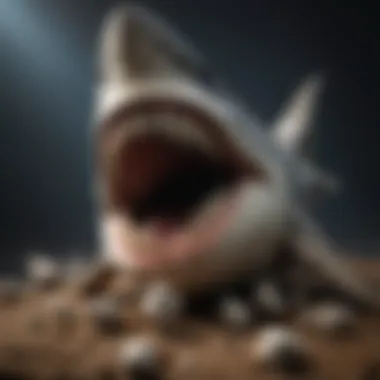
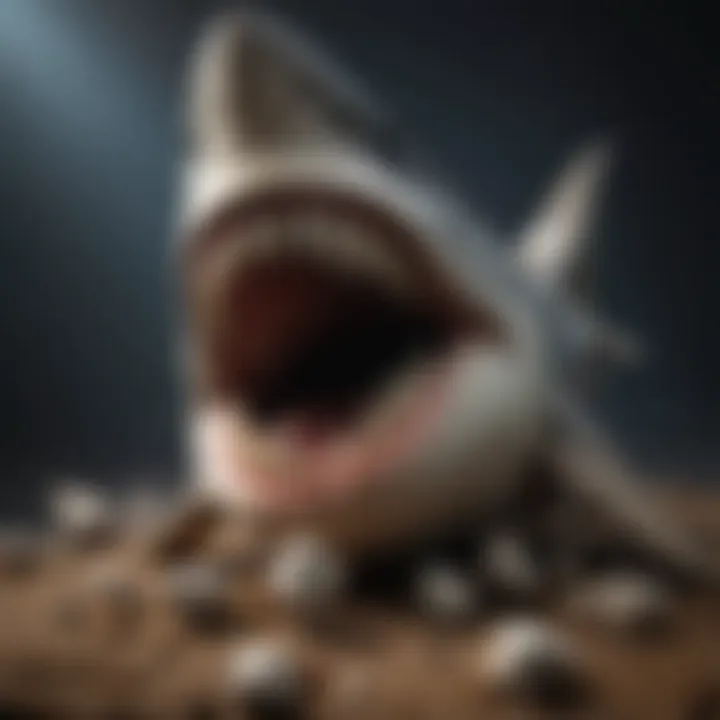
When it comes to mega shark teeth, there are a few key features that stand out and aid in identification:
- Size and Shape: Mega shark teeth, such as those from the Megalodon, are often larger than typical shark teeth. The distinct shape of the tooth can tell a lot about the species. For instance, the Megalodon teeth are broad and triangular, with serrated edges designed for cutting through flesh.
- Serration Patterns: The presence or absence of serrations can distinguish different species. For example, Carcharocles angustidens features finely serrated edges, while other species may have smoother surfaces.
- Color and Texture: The color can vary from black to tan, depending on the mineral content where the fossil was found. The texture can also indicate age, with older teeth often having a more polished appearance due to weathering.
- Root Structure: The root of the tooth often provides clues. Mega shark teeth will typically have robust roots, which are necessary to support their large size.
“The identification of a mega shark tooth is less about memorizing species and more about understanding characteristics. Each tooth tells a story.”
Resources for Identification
Arming oneself with the right tools and knowledge is essential for effective identification:
- Field Guides: Books like "Shark Teeth of North America" offer comprehensive overviews including images and descriptions that can be invaluable for collectors.
- Online Forums: Websites like Reddit have communities dedicated to paleontology and fossil collecting, where enthusiasts share their findings, tips, and identification techniques.
- Museums: Visiting specialized museums often helps in understanding the context of what you are collecting. They provide expert insights and sometimes even workshops on fossil identification.
- Social Media Groups: Platforms like Facebook host groups focused on fossil collecting, where you can ask for assistance in identifying your finds and get feedback from experienced collectors.
By diving into the specifics of identification and classification, collectors can not only enhance their personal collections but also contribute to the broader understanding of these fascinating artifacts from the past.
Collecting Mega Shark Teeth
Collecting mega shark teeth is more than just a hobby; it is a fascinating dive into both history and nature. For many enthusiasts, each tooth tells a story, whispering echoes from the oceans that once thrived with colossal creatures. Collectors often seek these remarkable artifacts not solely for their aesthetic appeal but also for their historical significance and the thrill of uncovering pieces of the past. However, it's imperative to approach this pursuit with a strong sense of responsibility.
Legal and Ethical Considerations
When it comes to collecting mega shark teeth, understanding the legal landscape is crucial. Different regions have various laws and regulations regarding the collection of fossils, especially those of significant scientific importance. For instance, in the United States, the legality of collecting may hinge upon whether the teeth are found on public land, private property, or protected sites. It's advisable to research local laws before embarking on a collecting expedition.
- Permits: In certain areas, you might require a collecting permit. Always check with local authorities.
- Protected Areas: Many fossilized locations are protected and prohibiting any collection helps preserve scientific data. Ignoring these restrictions can lead to heavy fines—and even legal troubles.
Ethically, one must weigh the impact of collecting on natural habitat. Being mindful of the environment ensures that future generations can also appreciate these teeth. Collecting responsibly involves only taking what is necessary and leaving the ecosystem intact.
"Collect responsibly, for the legacy you build today shapes the discoveries of tomorrow."
Best Practices for Collectors
Once the legal obligations are clear, adopting best practices in collecting mega shark teeth enhances both the experience and the integrity of the pursuit. Here are some helpful tips:
- Educate Yourself: Know the specifics about the various shark species. Distinguishing between a megalodon tooth and other shark teeth can enhance the thrill of discovery.
- Go on Guided Fossil Hunts: Joining tours with experienced guides not only aids in finding teeth but also educates about the local geology and paleontology.
- Invest in Quality Tools: Make sure to have the right digging tools. A small trowel, a sieve for smaller teeth, and a sturdy backpack for transport can make a significant difference.
- Fieldwork: Engage with diverse locations known for fossil beds. Beaches, riverbanks, and construction sites can often yield treasures, with each site offering a unique chance for discovery.
- Document Your Finds: Keep records of when and where you find each tooth. This practice is not only useful for your own cataloging but can also contribute to scientific knowledge if shared with local museums or institutions.
By following legal protocols and best practices, collectors can engage in this rewarding activity while minimizing their environmental footprint and maintaining the historical integrity of these ancient artifacts.
Collecting mega shark teeth opens doors to both adventure and education, giving participants a tangible connection to our planet’s distant past. As both a collector and a steward of nature, one can celebrate these remarkable treasures in a way that respects their long-standing history.
Preservation Techniques
When it comes to collecting mega shark teeth, preservation techniques play a pivotal role in maintaining the integrity and appearance of these remarkable specimens. The way you handle and preserve these fossils can significantly impact their longevity and value, making knowledge of preservation not just beneficial but essential for enthusiasts and collectors alike. Whether you're dealing with a tooth that has lit up the display case at a museum or one that you've unearthed on the beach, proper techniques can ensure it stands the test of time.
Cleaning and Restoration
Cleaning and restoration is a nuanced process that requires a delicate touch. While it may be tempting to scrub away years of sediment and grime, a hasty approach can result in irreparable damage. It's crucial to understand the materials and methods that are safest for cleaning shark teeth.
- Initial Assessment: Always begin with examining the tooth to determine its condition. Look for fractures, discoloration, and any signs of previous restoration. This will guide your cleaning and restoration process.
- Gentle Cleaning: Use soft brushes or cloths to remove loose debris. A small toothbrush can do wonders, but avoid using anything harsh.
- Soaking: If there is stubborn dirt, you may consider soaking the tooth in a solution of warm water and a few drops of mild detergent. This can help in loosening stubborn particles without the risk of physical abrasion.
- Drying: After cleaning, ensure proper drying to prevent mold and residue build-up. Use soft cloths for patting—no harsh rubbing.
- Restoration: For fractures, professional help is recommended. Alongside personal safety, professionals use techniques that can bond materials without compromising the fossil's integrity.
"Proper care and cleaning breathe life back into these ancient artifacts without stripping them of their character."
Display and Storage
Display and storage practices determine how well your collection maintains its beauty and authenticity. Arranging mega shark teeth for display isn't just about aesthetics; it's about preserving their condition.
- Display Cases: Consider using UV-protected glass display cases to shield your collection from harmful light and dust. This is crucial in preventing colors from fading and the formation of tarnish.
- Storage Options: For teeth not on display, acid-free boxes or containers are ideal. This prevents chemical reactions that can degrade the teeth over time.
- Handling Practices: Always handle shark teeth with clean hands or gloves. Oils and dirt from skin can introduce contaminants that may corrode the surface.
- Humidity Control: Keep an eye on humidity levels in your storage area. Excessive moisture can lead to mold or rust on any accompanying display materials.
Overall, the aim is to ensure that these stunning artifacts not only retain their physical qualities but also tell the story of their past. By adopting meticulous cleaning practices and thoughtful storage methods, collectors can protect their prized possessions from the ravages of time.
Cultural Impact
The examination of mega shark teeth transcends mere scientific inquiry. It dives into the cultural tapestry where these ancient relics have found a home, influencing art, literature, folklore, and even modern media. Their significance runs deep, often painting a picture of humanity’s quest to understand nature's grandeur and ferocity. The impact of these artifacts stretches beyond traditional paleontology, engaging imaginations and shaping perceptions in ways that ripple through generations.
Mega Shark Teeth in Popular Culture
The cultural allure of mega shark teeth is woven into various aspects of contemporary society. From blockbuster films to quirky reality shows, these formidable dental remains resonate with audiences worldwide.
- Films and Television: Movies like "Jaws" and the "Sharknado" franchise have undoubtedly propelled the shark mythos to the forefront of popular culture. The portrayal of sharks as both monstrous and awe-inspiring has sparked public fascination, often accentuated by the visual impact of shark teeth.
- Art and Decor: Artisans and collectors turning these teeth into jewelry or wall displays imbue them with personal stories and cultural value. They have become not just fossils but symbols of adventure and a connection to the ocean’s mysteries.
- Merchandising Madness: From casual souvenirs to high-end collectibles, mega shark teeth have taken on a life of their own in the marketplace. Specialized shops cater to enthusiasts, offering everything from raw specimens to polished pieces that narrate a journey through time.


Each representation in media and art molds the perception of mega sharks, reinforcing their status as icons of strength and fear. The 'larger than life' portrayal bridges the gap between reality and myth, stirring public curiosity and mythologizing these ancient predators.
Symbolism and Folklore
The symbolism attached to mega shark teeth is multifaceted, leaving a mark that resonates with diverse meanings. They are not simply remnants of fierce predators; they embody themes of power, survival, and the transitions of life itself.
- Strength and Ferocity: Many cultures view shark teeth as symbols of strength and resilience. In tribal traditions, such as those among Polynesian seafarers, shark teeth have been used in rituals, signifying courage and the ability to conquer the challenges of life.
- Ancient Lore: Folklore often attributes mystical qualities to sharks and their teeth. In some stories, shark teeth are said to possess protective capabilities, warding off evil spirits or bad luck. This contrasts sharply with their portrayal as fearsome carnivores but emphasizes humanity's complex relationship with nature’s raw power.
- Metaphorical Representations: The act of collecting mega shark teeth can symbolize a broader search for knowledge and connection to past epochs. Collectors find themselves intertwined with history, often aiming to uncover the narrative behind each specimen.
The End
In summary, the cultural impact of mega shark teeth showcases how these formidable fossils transcend their original context and become significant to human experience. They are versatile symbols that inspire awe, intrigue, and a sense of connection to both ancient times and our contemporary existence.
Research and Scientific Importance
Research regarding mega shark teeth transcends the mere fascination with these colossal objects; it serves as a gateway into a plethora of understanding about prehistoric marine ecosystems. These teeth encapsulate significant paleobiological data, offering insights into the diets, behaviors, and ecosystems of ancient sharks, particularly the notorious Megalodon.
Paleobiological insights derived from studying mega shark teeth can illuminate important ecological interactions. For instance, teeth morphology reflects the feeding strategies of these ancient predators. The serrations and shapes of the teeth can indicate whether a shark was primarily a scavenger or an active hunter. This type of analysis can furnish paleontologists with a clearer picture of the marine environment during different epochs. Matters of predation patterns and competition for resources can unravel layers of the evolutionary narrative, revealing how species adapted over millennia.
A dive into the fossil record of these teeth provides evidence for the geographical distribution and evolutionary lineage of species. By employing techniques such as radiographic imaging, researchers can observe subtle features that might be missed in a standard analysis. This opens avenues for discussions about extinction timelines and environmental pressures during those times. Such explorations have ramifications that stretch beyond mere academic interest; they help contextualize current marine biodiversity crisis within a historical framework.
"Mega shark teeth are not just objects; they are windows into the past, shedding light on marine life that once ruled the oceans."
Paleobiological Insights
Understanding mega shark teeth allows paleontologists to piece together the tale of marine life—an ancient drama where mega predators roamed. The morphometric analysis of these teeth can reveal secrets of the body sizes of these creatures, informing us not just about their physical traits but also offering hints on their hunting habits and ecological niche. From the throat of a whale to the depths of the ocean, these relics tell us about the food web relationships that existed millions of years ago.
For those interested in practical applications, identifying wear patterns on teeth aids in determining the diet of these ancient giants. Studies have shown that certain wear patterns correlate with specific prey types, further enriching our understanding of their role within these ancient ecosystems. Furthermore, the carbon isotopes found in fossilized teeth contribute to reconstructing ancient climates and habitats, indicating how these environmental factors influenced evolutionary pathways.
Contributions to Marine Biology
Mega shark teeth also contribute to modern marine biology in more nuanced ways. The study of these fossils can be linked to understanding current shark species. Insights into past marine predators can inform our management strategies for contemporary shark populations, which face numerous threats from overfishing and environmental change.
By examining the evolutionary adaptations of mega sharks to past environmental challenges, scientists can develop predictions about how current shark species might adapt or fail to adapt to ongoing ecological pressures. This line of research is not merely academic; it bears significant implications for conservation strategies today. In essence, lessons from the past guide the way forward.
Challenges in the Field
Understanding the challenges faced by collectors of mega shark teeth is not just a mundane detail; it is central to ensuring the sustainability and ethical treatment of this unique pursuit. The world of fossil collecting, while thrilling, is fraught with obstacles that can impact both the environment and the integrity of the market. Delving into these issues helps collectors navigate the complexities of their passion while maintaining a conscientious approach.
Environmental Issues
One cannot approach the collection of mega shark teeth without grappling with the environmental ramifications of fossil hunting. Coastal regions where these teeth are often found can be sensitive ecosystems. Over-collecting can lead to significant disruption of local flora and fauna. In places like the Beaches of South Carolina or the banks of the Peace River in Florida, throngs of collectors can cause habitat degradation, which in turn affects not just the local environment but the larger ecological balance.
Consider the following points when discussing environmental conservation in relation to mega shark teeth collection:
- Habitat Preservation: Oceans and their surrounding habitats are already under strain from pollution, climate change, and over-fishing. Removing fossils without considering the long-term impact can exacerbate these issues.
- Regulations and Guidelines: Many areas have guidelines in place that restrict how and when fossils can be collected. It is essential for collectors to familiarize themselves with these laws to protect these ecosystems.
- Sustainable Practices: The choice of where and how to collect can make a world of difference. Engaging in sustainable collecting practices ensures that collectors can enjoy their hobby without compromising the environment.
- Awareness and Education: Hosting or attending workshops on the ecological aspects of fossil collecting can help foster a sense of responsibility among collectors.
"A mindful collector is an advocate for the environment; it’s not just about finding treasure but preserving the story it tells."
Market Dynamics and Fraud
Equally troubling is the underbelly of the trade that arises from the commercial interests surrounding mega shark teeth. The lure of profit can lead to murky waters where fraud and deception prevail. Collectors should be on guard against fake specimens and misleading claims, as the market can sometimes feel more like a minefield than a treasure trove.
Key elements to consider include:
- The Rise of Counterfeit Teeth: With the increasing popularity of mega shark tooth collecting, the market has seen a rise in counterfeit items. Many sellers churn out replicas that look convincing but lack authenticity. It is crucial to be able to identify genuine artifacts vs. fakes.
- Price Fluctuations: The value of actual mega shark teeth can vary significantly based on size, condition, and provenance. Collectors should be informed about current market trends to avoid falling prey to inflated prices.
- Importance of Provenance: Purchasing specimens with clear and credible provenance can help protect against fraud. Knowing the history of a piece enhances its value and maintains its integrity.
- Ethics in Selling: Its vital for dealers and sellers to operate within ethical boundaries and not capitalize on desperate collectors looking for that elusive find.
In navigating these tumultuous waters of market dynamics, collectors must remain vigilant. It’s vital to cultivate reputable sources, continuously educate oneself, and become part of a network of trustworthy fellow enthusiasts.
Closure
As we wrap up this exploration of the mega shark tooth, it is critical to reflect on the multifaceted importance of this topic. This article serves not only as a guide for collectors and enthusiasts but also as a call to engage with the vast histories and ecosystems that these teeth represent.
The Future of Mega Shark Tooth Collecting
The future of collecting mega shark teeth is looking both exciting and challenging. With increasing interest from a diverse audience—from casual beachcombers to serious paleontology fans—new opportunities are arising.
However, this growing popularity comes with responsibilities. One critical aspect involves awareness and adherence to legal and ethical guidelines surrounding fossil collection. It’s a tricky landscape. Collectors need to ensure they're not disrupting ecosystems or violating laws designed to protect natural resources.
- Sustainable Practices: Collecting responsibly is essential. Limit your take and respect local regulations. There’s no need to reshape nature unduly—there are plenty of fossilized treasures waiting to be discovered without causing harm.
- Community Building: Joining local fossil groups or online forums like Reddit allows new collectors to connect with seasoned experts. This exchange of knowledge can be invaluable for anyone looking to deepen their understanding of the practice.
- Educational Focus: Institutions like museums often invite collectors to lend their specimens for educational displays. Collaborative efforts can help to further enrich knowledge around mega shark teeth, making it a win-win situation for collectors and the broader community.
Far from just being a hobby, the practice of collecting mega shark teeth is a gateway into deeper ecological and historical dialogues. It challenges collectors and enthusiasts alike to think beyond mere possession and embrace a stewardship role. The teeth aren’t just relics; they’re echoes of ancient life, stories from the past that have much to teach us if we choose to listen. In this sense, the future of mega shark tooth collecting can symbolize a shared commitment to preserving our planet's history while fostering curiosity in generations to come.
"Ultimately, the journey of a collector involves not just accumulating items, but understanding and appreciating the stories behind them."
Remember, as you explore this fascinating field, you’re not alone. Engaging with fellow passionate individuals can deepen your experience and broaden your perspective of what these amazing artifacts represent.



